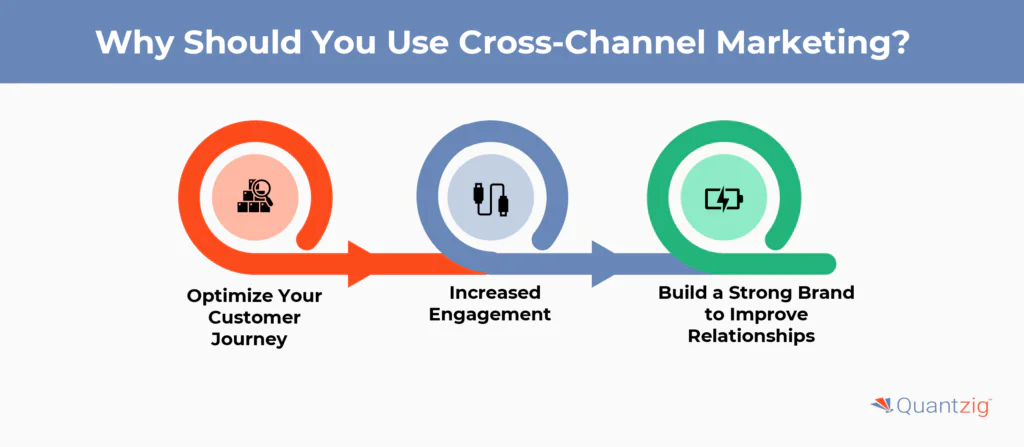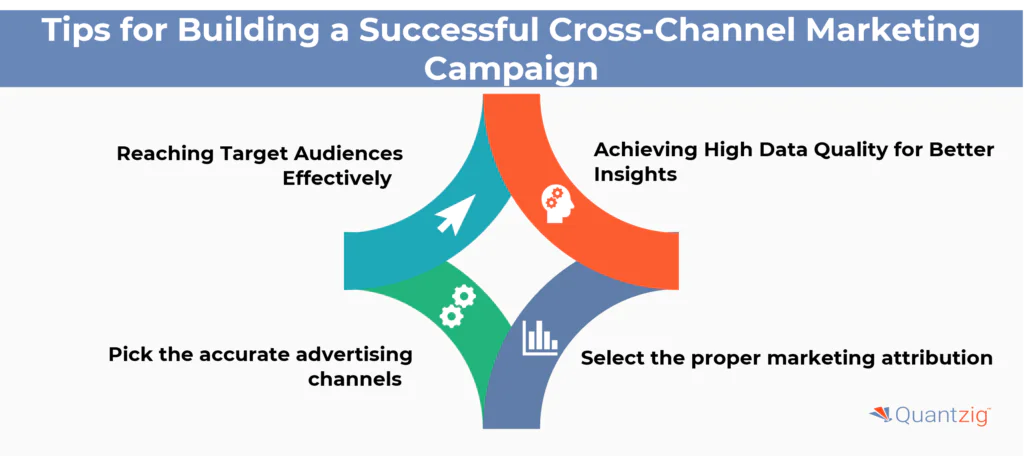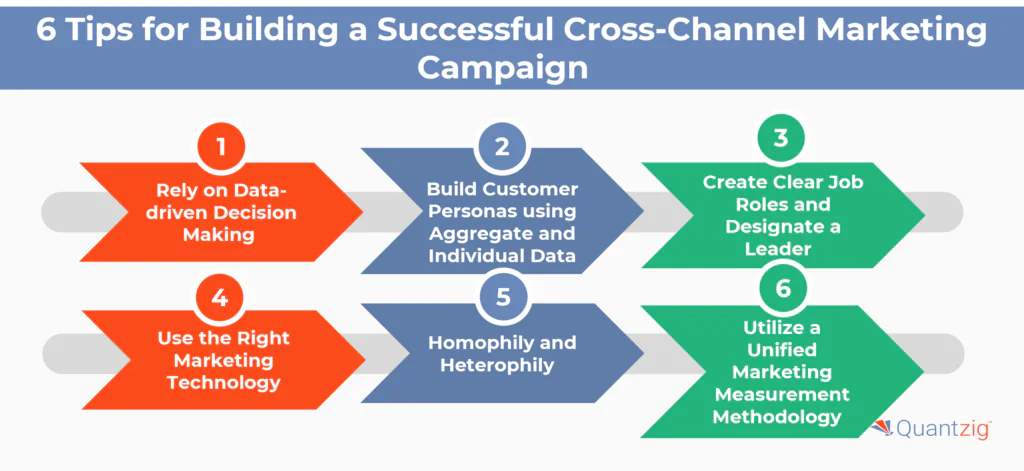Written By: Sudeshna Ghosh
Table of Contents
Key Takeaways for Cross-Channel Marketing Strategies
- Integrated Customer Experience: Cross-channel marketing is essential for constructing a unified customer experience across diverse platforms and touchpoints. By engaging customers at various stages of their journey, businesses can tailor their messaging and offerings, ultimately enhancing customer satisfaction and loyalty.
- Data-driven Decision-Making: Successful cross-channel marketing relies on data-driven decision-making processes. By leveraging high-quality data gathered from multiple channels, businesses can identify trends, understand consumer behavior, and optimize their strategies for maximum effectiveness.
- Strategic Leadership and Technology: Effective implementation of cross-channel marketing requires strategic leadership and the right marketing technology. Designating a leader and utilizing appropriate marketing tools enable organizations to streamline communication, optimize ad placements, and create cohesive customer journeys.
- Continuous Optimization and Measurement: Constant optimization and measurement are crucial for success in cross-channel marketing. By continuously monitoring key performance indicators (KPIs) and utilizing unified measurement methodologies, businesses can refine their campaigns, maximize their budget, and foster lasting customer relationships.
Introduction
In the present day, consumers have more influence than before, so marketers must engage with their target market wherever they are. This requires identifying the platforms consumers use and when they use them. Focusing on just one channel won’t provide a complete view of the audience, which makes crafting a personalized customer experience difficult. With cross-channel marketing, you can consider every interaction point, letting you fine-tune your messaging at each step as the customer connects with your brand.
Book a demo to experience the meaningful insights we derive from data through our analytical tools and platform capabilities. Schedule a demo today!
Request a Free DemoQuantzig’s Expertise in Cross-channel Marketing Solution for a US-based CPG Multinational Brand
| Category | Details |
|---|---|
| Client Details | A multinational CPG brand with a diverse product portfolio. |
| Challenges Faced by The Client | The client had decentralized execution for digital and non-digital channels with centralized budgeting, using a once-a-year planning approach. Their existing MMM couldn’t provide dynamic plans for digital channels or leverage internal marketing performance data effectively. |
| Solutions Offered by Quantzig | Updated MMM + MTA solution for dynamic planning, attribution modeling, ROI analysis, simulation toolkit. |
| Impact Delivered | 12% uplift in MMM performance, 7% improvement in ROMI on key channels in next cycle. |
Client Details
A multinational CPG brand with a diverse product portfolio.
Challenges Faced by the Client
The client is CPG Multinational with decentralized execution for both digital and non-digital channels along with centralized budgeting. With a once-a-year planning approach and a more antiquated approach, their current MMM was unable to offer dynamic plans for digital channels or turn client-specific internal marketing performance data into solutions.
Solutions Offered by Quantzig
With the MMM + MTA solution, Quantzig assisted the client in updating the model using more recent weekly data, resulting in more flexible plans that took the recency effect into account throughout the year rather than just at the beginning of the annual marketing cycle. After constructing the intelligence layer, we developed attribution models for the channels without a direct means of identifying revenue share.
Subsequently, we computed the initial revenue and analyzed the total revenue for each channel. Then, using ROI measurements, we determined the channels’ sensitivity and effective spending limits. Finally, we enabled a simulation toolkit so that marketing analysts could experiment with various budgeting scenarios and channel allocation.
Impact Delivered
The newly implemented MMM solution delivered significant impact for the client. It resulted in a remarkable 12% uplift in performance compared to the original model. Moreover, the client experienced a notable 7% improvement in Return on Marketing Investment (ROMI) on key channels during the subsequent marketing cycle following the adoption of the solution.
What is Cross-Channel Marketing?
Cross-channel marketing integrates various marketing channels to construct a more unified customer experience for your intended audience. The channels should collaborate to generate a coherent narrative that guides consumers from one phase to the next. By interacting with customers across diverse contact points, marketers can use people-focused marketing to assemble comprehensive profiles that assist in tailoring the customer journey and cultivating loyalty.
Why Should You Use Cross-Channel Marketing?

In today’s digital age, marketers have more opportunities than ever before to connect with and understand consumers. Adopting a comprehensive, cross-channel approach provides significant advantages.
1. Optimize Your Customer Journey
Studies show holistic campaigns that utilize multiple channels improve budget efficiency by 15-20% by better-attributing tactics to consumer actions. Research also indicates that 73% of shoppers use multiple channels before purchasing. Marketers must meet customers where they are – across offline and online touchpoints. To fully understand the modern customer journey, marketers can’t rely on siloed data and campaigns. Rather, unified databases that centralize customer information are necessary for a complete view. With consumers spanning channels, marketers should ensure integrated, cross-channel strategies versus fragmented efforts. Ultimately, a holistic approach enables deeper consumer insights and optimization across the entire customer journey.
2. Increased Engagement
Customers who use many channels to interact with retail brands are extremely valuable, as 62% of those surveyed who use 10 or more retail channels make purchases at least weekly. Strong emotional bonds between customers and brands are formed through engaging interactions, which can be the key factor in turning target audiences into loyal brand fans.
Since customers connect with brands across diverse channels, brands must actively put themselves in front of customers instead of passively waiting to be found. Strategic hashtag uses and direct response marketing that spurs the sharing of content can be effective engagement drivers. Essentially, anything that gets people interacting with the brand helps build meaningful engagement over time.
3. Build a Strong Brand to Improve Relationships
Leveraging multiple channels provides more exposure, enabling you to build a stronger brand and boost customer loyalty. Take Apple for example: They have physical stores, a clean website, TV ads, and digital marketing. By adhering to consistent branding and style guidelines, they maintain a steady look and message across all touchpoints.
The different channels complement each other – the physical stores support the whole Apple ecosystem, and customers aren’t necessarily expected to buy something when they visit a store. This creates a comprehensive brand experience, rather than relying solely on the moment of purchase. Each channel complements the next, working in unison to build an immersive brand experience.
Challenges of Cross-Channel Marketing

Executing omnichannel marketing across multiple channels can be difficult because it changes a straightforward, simple customer experience into something much more intricate and complicated. When starting a cross-channel campaign, brands must assess many media platforms, and new channels keep emerging. Many companies find themselves lagging in adopting new platforms, resulting in some common obstacles.
1. Reaching Target Audiences Effectively
With the proliferation of marketing channels, marketers face challenges in identifying the optimal ways to connect with their intended audiences at the right moment. The vast array of options makes it tough to predict which platforms and timing will best reach consumers, especially as user behavior and advertising capabilities on these channels continue to evolve.
Per 40 percent of marketers, a major struggle is leveraging advanced tactics to target their core demographics at the ideal juncture. Media planners must choose when to display ads across platforms and follow best practices for each channel, as approaches effective for TV ads won’t work for Facebook posts. Planners must grasp what messaging resonates on each channel.
In summary, the expansion of marketing channels presents difficulties for marketers in pinpointing how to effectively reach their target audiences at the opportune time. With users and advertising changing on these platforms, planners must understand timing and messaging differences across channels to connect with their core demographics.
2. Achieving High Data Quality for Better Insights
Data quality remains a major challenge for many companies. Approximately 34 percent of data leaders want to better leverage data insights for business decision-making. However, 42 percent of customer analytics professionals cite data quality as their top struggle.
The volume of data gathered by companies continues to grow. It’s critical to identify truly relevant data for boosting efficiency and understanding consumer behavior. Higher data quality leads to more accurate insights, enabling data-driven marketing decisions. Without high-quality data, marketers struggle to obtain actionable, individual-level insights to guide future choices.
Additionally, as we approach a cookieless future, marketers must reevaluate why and how they collect certain data. Many organizations today depend on the insights from cookies and other tracking tools, but these information sources will soon virtually disappear. This looming challenge will further highlight the need for high-quality data.
3. Pick the accurate advertising channels
Selecting the right advertising. media channels can be a challenge for most organizations because of how difficult it is to determine where your target audience is spending most of their time, and when. Not all platforms will reach your target audience, which is why it’s so important to understand the consumer on a granular level.
When creating a cross-channel plan, campaigns need to work together across the channels your target audience engages with to increase the chances of getting your message in front of them at the right time. When choosing an advertising channel, consider the value of each channel and its place in the customer journey. It’s also important to keep the main objective of the campaign in mind – Is it to capture leads? Generate impressions? Improve engagement? Whatever it may be, you must evaluate which channel is going to be able to give you the results that you’re looking for.
4. Select the proper marketing attribution
Many brands still lag when it comes to marketing attribution and data quality. Consider the following points:
Only 21 percent of marketers have implemented a marketing attribution model and regularly use it in their campaigns.
Less than half of corporate strategies mention data and analytics.
Marketers continue to focus on metrics like click-through rates while ignoring other important metrics. If 1 percent of people click an ad, the other 99 percent who saw it but did not click are often not counted, even if the ad influenced them to convert later.
Media mix modeling (MMM) and multi-touch attribution (MTA) have limitations around marketing analytics. They can’t be combined, provide real-time data, or give a complete view of campaigns. Instead, marketers should take a more comprehensive approach to attribution by combining raw data and individual-level insights.
Also Read: Maximizing Marketing Budgets with Campaign ROI Analysis
Get started with your complimentary trial today and delve into our platform without any obligations. Explore our wide range of customized, consumption driven analytical solutions services built across the analytical maturity levels.
Start your Free Trial Today6 Tips for Building a Successful Cross-Channel Marketing Campaign

The objective of cross-channel marketing is to provide customized and engaging experiences for customers. Consider these best practices when designing a campaign:
1. Rely on Data-driven Decision Making
To develop a successful campaign, companies need to be data-driven. They must consider who their target market is, what platforms they frequently use, and what messaging resonates with them. High-quality data gathered from multiple channels will identify trends and patterns in behavior that can inform your audience’s preferences and choices and increase marketing ROI.
2. Build Customer Personas using Aggregate and Individual Data
Comprehensive customer profiles can help assess your target audience’s motivations and shopping behaviors and better understand who they are and what they already engage with. By combining both aggregate and person-level customer data, you can uncover commonalities between groups, allowing you to identify segments within your audience. These insights can then be leveraged to drive future strategies and messaging and create repeatable success.
3. Create Clear Job Roles and Designate a Leader
According to a marketing effectiveness survey by Gartner, 60% of organizations that said they were outperforming their peers had a position dedicated solely to multi-channel marketing. In the same survey, nearly all respondents said they had someone leading multi-channel marketing at least at the director level or higher. About 30% of CMOs are in charge of this function, while 56% of respondents report directly to the C-suite.
Cross-channel marketing can be complex and detail-oriented. It mustn’t be treated as just an extension of the marketing strategy but as the strategy itself. Having a designated leader helps keep the whole team on track and with a clear understanding of each channel’s role.
4. Use the Right Marketing Technology
Strong analytics give us actionable insights into customer preferences, so it’s crucial to choose marketing technology that gathers accurate, high-quality data. Automation is another key functionality to consider when deciding what tools will best fit your company’s needs. With the right marketing performance solutions, marketers can gain a more holistic view of their target audience. Among other things, marketing technologies should enable the marketing team to optimize:
- When they show ads
- Which channels do they display ads on
- The messages they use to interact with their target audience
An effective marketing tech stack should streamline communications and help create a cohesive customer journey that identifies and utilizes the channels and messages that your target audience engages with most.
5. Continuously Enhance Multiple Key Metrics
The crucial element for creating successful marketing campaigns is to assess previous performance and apply the lessons learned to future tactics. Companies should be constantly optimizing for various key performance indicators (KPIs) across the whole marketing funnel. The data accumulated can give marketing teams important insights into return on investment, enabling them to make informed choices about how campaigns can be further enhanced moving forward.
6. Utilize a Unified Marketing Measurement Methodology
A unified marketing measurement methodology offers a comprehensive perspective of each channel and campaign, how they influence one another, and their overall impact on driving conversions. By considering all of these factors, companies can better grasp each campaign’s effect on driving conversions. This will provide a more precise view of all marketing campaigns and how they interact and affect each other, allowing marketers to maximize their budget and avoid waste in advertising.
Examples of Brands Using Cross-Channel Marketing
When executed properly, cross-channel marketing can provide brands with deeper insights into their customers that can inform future campaign decisions. Two examples of brands finding success with multi-channel campaigns are:
1. Mercedes Benz
Mercedes Benz used both digital and traditional tactics in their campaign to launch the CLA model, calling it their best product debut in 20 years. They leveraged insights from their online “Generation Benz” community to guide strategy and understand users.
To introduce the CLA, they aired a Super Bowl ad featuring Usher and Kate Upton (notably, at the Mercedes-sponsored stadium). They created a microsite, purchased Facebook ads, and used the hashtag #clatakethewheel to drive engagement. They also partnered with popular Instagrammers and YouTuber Casey Neistat for influencer marketing. By the campaign’s end, Mercedes garnered over 85 million organic impressions and roughly 2 million likes. The CLA launch alone was responsible for a 14 percent sales increase year-over-year in November.
2. Starbucks
Starbucks has seamlessly integrated online and offline experiences through its app. The app uses a reinforcement learning platform to reward customers for purchases and provide personalized recommendations tailored to their shopping behavior. Push notifications inform users about sales and promotions, driving more in-store traffic.
By providing an integrated experience, Starbucks connects with customers at nearly every moment. Artificial intelligence provides consumer insights that not only understand but predict behavior. Customers can conveniently check and reload their Starbucks card directly from their phone, enabling seamless purchasing from anywhere at any time.
The Essential Elements of Cross-Channel Marketing
Cross-channel marketing integrates various platforms and channels to provide a unified and personalized experience for customers. At its heart, this strategy acknowledges that consumer behavior varies across different touchpoints. By gaining insights into their audience, marketers can adapt their tactics to connect with target consumers at each phase of the customer journey. This means leveraging the capabilities of diverse channels like email, social media, and other digital platforms to interact with customers where they are most engaged. Through understanding individuals, brands can build deeper bonds by catering to specific preferences and behaviors, ensuring each interaction contributes to a smooth and meaningful experience.
Fundamental to effective cross-channel marketing is the ability to monitor and quantify performance across channels and touchpoints. Using tracking tools like unique URLs enables marketers to evaluate campaign impact and optimize approaches for maximum conversion. A successful cross-channel strategy is more than just presence on multiple platforms; it requires meticulous integration of channels within a broader digital ecosystem. Using platforms like Journey Builder, marketers can map the customer journey and implement a cohesive multi-channel plan that seamlessly guides consumers from awareness through conversion. By embracing the complexity of modern consumer engagement, marketers can realize the full potential of cross-channel marketing to drive success and foster lasting customer relationships.
Also Read: Track Business Progress with Marketing Analytics Dashboard
Experience the advantages firsthand by testing a customized complimentary pilot designed to address your specific requirements. Pilot studies are non-committal in nature.
Request a Free PilotHow can Quantzig Help You with Cross-channel Marketing?

Quantzig provides a wide range of solutions to help businesses navigate the complexities of cross-channel marketing successfully. By utilizing advanced analytics and data-driven insights, our team allows marketers to gain a deep understanding of consumer behavior across various platforms and channels. Through analyzing tracking metrics and implementing unique tracking URLs, businesses can accurately measure the impact of their campaigns and optimize their strategies for better conversion. Our expertise in multi-channel marketing means that marketers can interact with their target audience seamlessly across different touchpoints, promoting a unified and engaging customer experience.
One of Quantzig’s key strengths is its skill in people-based marketing, which allows businesses to personalize interactions and build meaningful relationships with customers throughout their journey. Through a comprehensive multichannel approach, we assist businesses in building a robust digital ecosystem that combines email marketing, social media, and other channels to increase reach and engagement. Using cutting-edge tools like Journey Builder, we enable marketers to map out the customer journey and orchestrate tailored campaigns that resonate with their target audience at every stage.
With Quantzig’s customized solutions, businesses can unlock the full potential of cross-channel marketing to drive success and sustainable growth. Whether optimizing email marketing campaigns or enhancing presence on social media, we provide the expertise and tools required to thrive in today’s competitive environment. Embrace Quantzig’s innovative approach to multichannel marketing and elevate your brand’s visibility and impact across digital platforms.
Conclusion
A multi-channel marketing approach lets companies build a seamless customer experience across all marketing channels. Nowadays, companies can use sophisticated solutions that automate complex tasks, enabling them to fine-tune marketing efforts for continuous improvement. By steadily tracking campaign performance and guaranteeing brand consistency and relevant content at every interaction during a campaign, your company can lead customers through a unified journey that promotes participation and cultivates brand devotion and retention.



